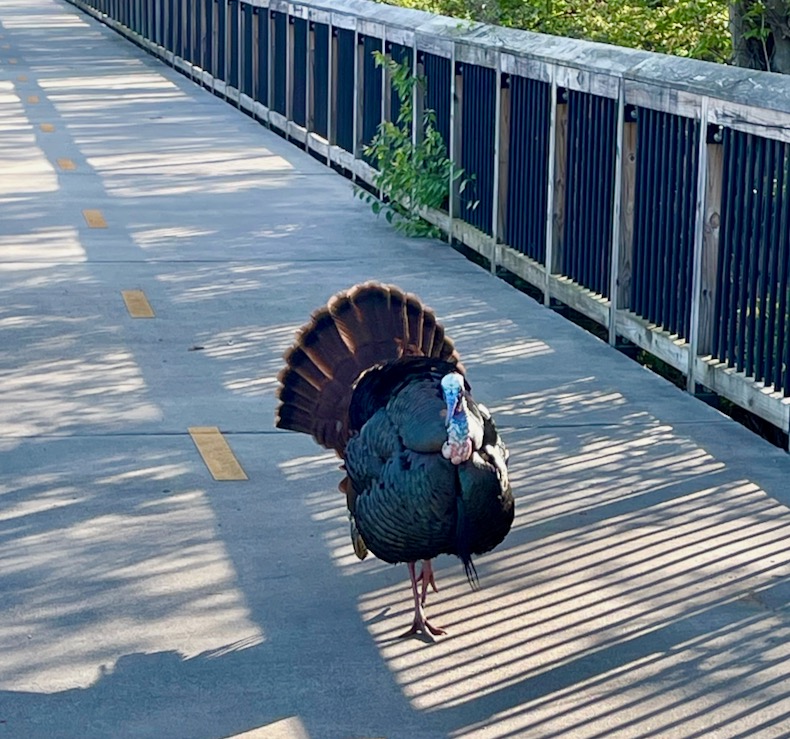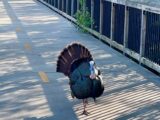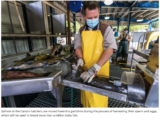The Big Picture –
By Glynn Wilson –
WASHINGTON, D.C. — It’s admittedly a few days late for a Thanksgiving turkey story.
The White House turkeys were pardoned again this year by President Joe Biden in the annual American Thanksgiving tradition, while 46 million turkeys were consumed over the holiday weekend, according to the University of Illinois extension service.
But I just received the photograph to go with this heroic tale, so please, without objection, I will finally reveal the ending to a story that enthralled the Washington region last spring about the time I was heading north into the Catoctin Mountains for the summer.
Perhaps you saw a version on the wires, or the local television news or videos on YouTube or Twitter. A large male turkey, a.k.a. a tom, not to be confused with an Uncle Tom, was seen attacking people along a popular trail along the Anacostia River by Kenilworth Park and Aquatic Gardens.
Feature writers in newspapers around the region fell all over themselves to sensationalize the story and make it funny for humor starved audiences in a stressed out world still suffering some from the coronavirus pandemic.
The Washington Post called it fowl play. In the Washington Examiner, it was overplayed just a bit with the headline: Wild turkey terrorizes DC.
Even the National Park Service rangers who were among the first to encounter the aggressive bird had a field day with the fowl behavior, calling the organized attempt to capture and move the bird “Operation Early Thanksgiving.”
Ranger Joe Cashman from Kenilworth Park even turned the turkey story into an interpretive campfire circle ranger program, and he joined ranger John Reid in a comprehensive Thanksgiving turkey program in Greenbelt federal park, where the end of the story was revealed.
As is typical of these great American stories told by park rangers in their iconic forest green uniforms and Smokey Bear hats, they should include the thoughts of a founding father or two.
In this case that means the famous story of Benjamin Franklin recommending the wild turkey over the bald eagle as America’s national symbol and bird, even though it’s a myth and was told only in jest, and after the fact.
“For my own part I wish the bald eagle had not been chosen as the representative of our country,” Franklin wrote in a letter to his daughter Sarah. He was poking fun, but he argued that the eagle, a scavenger by nature, was “a bird of bad moral character” that “does not get his living honestly” since it steals food from the fishing hawk and is “too lazy to fish for himself.”
By way of contrast, Franklin called the wild turkey “a much more respectable bird” and “a true original native of America.” He called the eagle “a rank coward,” but the turkey “a bird of courage” that “would not hesitate to attack a grenadier of the British Guards who should presume to invade his farm yard with a red coat on.”
For several months, a number of bikers, joggers and hikers reported being attacked and chased on the Anacostia Riverwalk Trail, which straddles the D.C. and Maryland lines by Kenilworth Park and Aquatic Gardens and the Kenilworth Recreation Center in Northeast Washington, by this courageous tom.
It was seen and photographed running right at people, flapping its wings, all puffed up to look big to detract predators. It scratched several people with its talons, and in general, gobbled at a lot of people.
One man posted on a blog that he sustained puncture wounds to his legs, a wound that required a tetanus shot.
Wildlife experts urged caution, and organized a search to try to catch and move the turkey to a wildlife refuge, away from the highly populated urban area.
“He is one bad actor,” said Dan Rauch, a wildlife biologist for the D.C. Department of Energy and Environment. “This should not reflect badly on all turkeys.”
In researching the encounters along the Anacostia, Ranger Cashman discovered similar stories in parks around the country. Wild turkeys are protected under the Migratory Bird Treaty Act. But because this tom attacked people, it was deemed a public safety hazard and a “nuisance.” Officials said they are thereby allowed under the law to capture and move the tom to a wildlife sanctuary.
For months, the aggressive bird managed to elude capture. Turkeys are smart and agile, able to run as fast as 25 miles per hour, and fly better than people might expect considering their heft, about 20 to 25 pounds.
Turkeys tend to behave more like chickens when they see humans, and are normally very shy birds and often hard to photograph as a result. But for some reason the Anacostia tom seemed to have no fear of people.
It turns out this aggressive behavior is not so unusual during mating season in the spring. It’s just rare in highly populated urban areas, and now because of social media, more people find out about such escapades.
It could also be that this one was fed by people, a serious violation of human-wildlife behavior and strictly prohibited by policies of the National Park Service.
“It is unusual for a wild animal to approach a human, but if someone has been feeding it, animals will become desensitized, and they are more likely to approach,” said Lauren Crossed, wildlife program manager at the Humane Rescue Alliance in D.C., who was involved in trying to trap the turkey. And if a person then does not feed the turkey, she said, it could get angry.
Wild turkeys have made a comeback in the region in recent years due to conservation measures. They nearly disappeared 50 years ago due to over hunting and urban development.
But there is a healthy population in Greenbelt Park between Baltimore and Washington along the Baltimore-Washington Parkway now, and they can be spotted in the National Arboretum, Rock Creek Park, Fort DuPont, or near the Frederick Douglass Memorial bridge.
“Sightings of wild turkeys are common,” Crossed said. “The uncommon part with this one is that he is aggressively chasing people.”
Of course the turkey drew the attention of federal and state bureaucracies, with no less than five agencies joining the crusade to capture old Tom, along with local non-profit Humane Society groups. It was a full-blown NCIS investigation and search.
The National Park Service was there at the start, where rangers were among the first to personally be chased by the belligerent bird. The U.S. Fish and Wildlife Service, another Department of the Interior agency, sent personnel to engage. Not to be outdone, the U.S. Department of Agriculture also had to get involved, along with the D.C. Department of Energy and Environment. The Maryland Department of Natural Resources also offered to join the turkey hunt.
“We tried baiting him. We went out with turkey calls,” Crossed said. “We looked at victims to see if there is something they had in common or if there is something about the location of the attacks. There is nothing consistent.”
At one point, agencies considered dressing up some of their staff as joggers to try to lure the turkey into a trap.
One park ranger started biking along the trail three times a day trying to spot the turkey and was in radio contact with others in the Turkey Task Force, equipped with raptor gloves and a blanket. They even tried using a female hen decoy.
Several times rangers had the bird cornered by the water, Cashman said.
“But every time it just took off across the river,” he said, disappearing into a wooded area with no trails to continue the chase.
They never did catch that old turkey, and no one knows what happened to him.
“I wish I had a more satisfactory ending for you,” Ranger Cashman said as he concluded his turkey tale in the ranger program by the campfire.
But maybe that’s the most satisfactory ending of them all. Perhaps old Ben Franklin was right.
This smart and courageous bird outfoxed the entire federal government, and old Anacostia Tom could still be out there somewhere, spreading his seed amongst the hens of the Washington region.
Why it’s a Thanksgiving story of evolutionary success. Talk about survival of the fittest, this Anacostia Tom should win the Presidential Medal of Freedom — not that the Secret Service could find this tom to present him with the award.
___
If you support truth in reporting with no paywall, and fearless writing with no popup ads or sponsored content, consider making a contribution today with GoFundMe or Patreon or PayPal.














